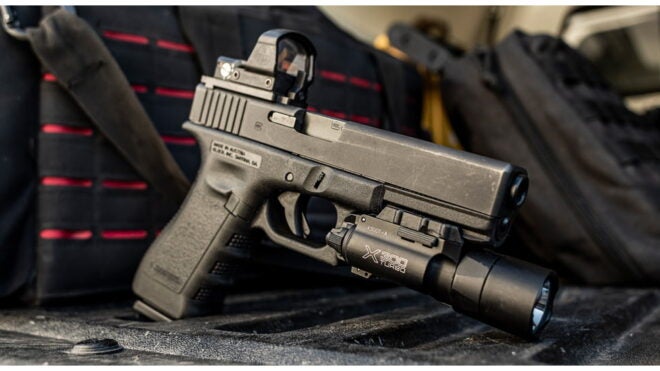In the world of tactical gear, a weapon-mounted light is not just an accessory – it’s a critical tool that can mean the difference between clear sight and obscurity, accurate identification and guesswork. Whether you’re a law enforcement officer, a hunter, or a responsible civilian who believes in the right to self-defense, the right weapon light can enhance your accuracy, identify threats, and even disorient potential attackers.
However, not all weapon lights are created equal. There are several key factors to consider when choosing a weapon-mounted light to ensure it meets your specific needs and holds up under pressure—because the last thing you need in a critical situation is for your equipment to fail. We’ve written about many weapon-mounted lights over the years; this guide is about a handful you can find today.
This guide will walk you through the main considerations when choosing a weapon-mounted light: battery life, lumens, candela (light intensity), size, durability, and design. By understanding these factors, you can make an informed decision and choose a light that won’t disappoint you when it matters most. Let’s shed some light on the subject! Hyuck, hyuck, hyuck…
2023 Fall Buyer’s Guide: Choosing Your Perfect Weapon-Mounted Light
Factors to consider
Battery Life
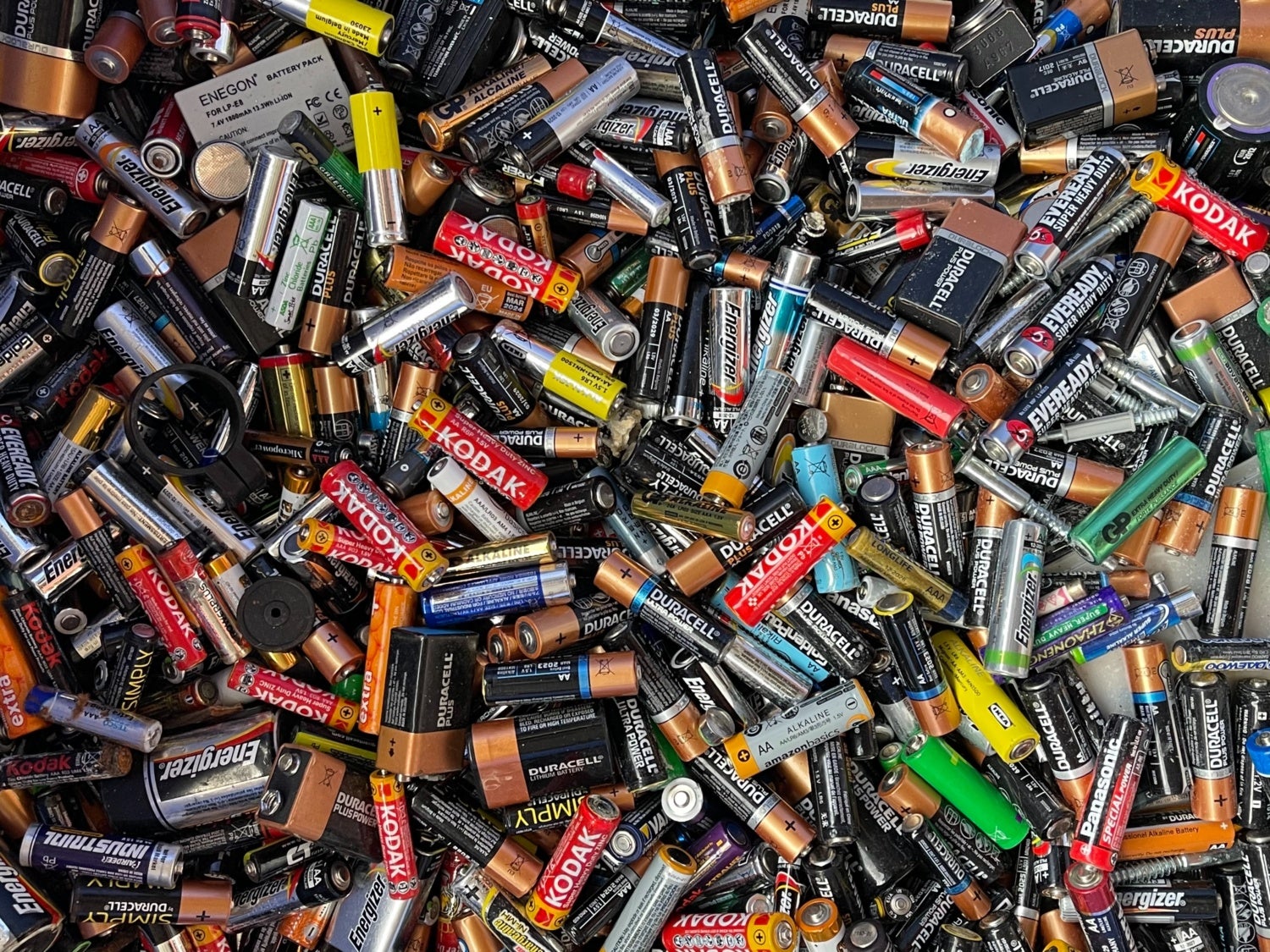
Photo by John Cameron on Unsplash
The last thing you want in a high-pressure situation is for your light to die. That’s why considering battery life is paramount when choosing a weapon-mounted light. Some lights use disposable batteries, while others are rechargeable. Disposable batteries can be convenient, but they require you to have replacements on hand. Rechargeable batteries, however, can save you money in the long run and are more eco-friendly. Consider your typical usage and choose a light with a battery life that comfortably covers your needs.
Regarding the lifeblood of your weapon-mounted light, battery life is a critical factor that demands careful consideration. This is not merely about convenience but ensuring your light functions when needed. A light that goes out in a high-pressure situation could have disastrous consequences, thus underscoring the importance of reliable battery life.
Weapon-mounted lights utilize two main types of batteries: disposable and rechargeable. Each type has its own set of advantages and potential drawbacks.
Disposable Batteries
Disposable batteries are often favored for their accessibility and ease of replacement. Common types used in weapon lights include CR123A or AA batteries, both of which can be found in most stores. The convenience factor lies in the ability to swiftly replace batteries on the go, ensuring your light remains operational. However, this requires you to keep a stock of spare batteries on hand, which could be cumbersome during extended use. Furthermore, the recurring cost of replacements and the environmental impact of disposing of used batteries are important considerations.
Rechargeable Batteries
On the other side of the spectrum, we have rechargeable batteries. These are typically lithium-ion batteries that can be recharged using a standard USB cable. While the upfront cost may be higher, rechargeable batteries are more cost-effective over time as they eliminate the need for constant replacements. In terms of environmental impact, they are also a more sustainable choice since they produce less waste while helping support overseas labor.
However, rechargeable batteries come with their own set of challenges. Charging times can vary, and you’ll need access to a power source to recharge them. In situations where you’re away from a power source for extended periods, this could pose a problem.
When evaluating battery life, consider your typical usage patterns and the environments you’ll be operating in. If you’re engaged in long outdoor excursions without access to a power source, having a light that uses disposable batteries may be more practical. Conversely, a rechargeable option might be better if you’re using your weapon light closer to home or in situations where you can easily recharge batteries.
In essence, the choice of battery type should align with your operational needs and the tactical situations you anticipate encountering. Choose a weapon-mounted light with a battery life that comfortably covers your needs and complements your usage scenarios for optimal performance.
Lumens
Lumens measure the total amount of visible light emitted by a source—in this case, your weapon light. The higher the lumens, the brighter the light. But remember, more isn’t always better. Extremely bright lights might cause temporary blindness, especially in close quarters, which can be disorienting. However, a higher lumen count could benefit outdoor or long-range applications. Consider your typical environment and choose a lumen count that provides adequate illumination without causing discomfort or disorientation.
Regarding weapon-mounted lights, lumens are the unit of measurement that indicates the total quantity of visible light emitted. In simpler terms, we typically refer to lumens when discussing how bright a light is. The higher the lumen count, the brighter the light output.
However, it’s crucial to understand that more lumens don’t necessarily equate to better performance in every situation. Let’s delve deeper into this concept.
The Role of Lumens in Different Scenarios
A high-lumen light can be overly bright in close-quarter situations, such as indoor environments or confined spaces. The intense light could bounce off nearby walls or objects, potentially causing temporary blindness or disorientation. This ‘backflash’ effect could hinder your vision rather than help it. Therefore, a moderate lumen count might be more suitable for close-range applications.
On the other hand, for outdoor environments or long-range applications, a higher lumen count can be beneficial. More lumens can help illuminate larger areas and allow you to identify potential threats from a distance. For instance, if you’re engaged in nighttime hunting or patrolling large, open spaces, a high-lumen weapon light can provide the broad, bright beam necessary to light up your surroundings effectively.
Striking a Balance
Choosing the right lumen count requires balancing adequate illumination and potential discomfort or disorientation. It’s about finding a light that provides enough brightness to clearly discern targets without hindering your vision.
To strike this balance, consider your typical operating environment and your specific needs. A weapon light with a moderate lumen count may suffice if you primarily operate in close quarters. Going for a higher-lumen light might be a more fitting choice if your activities often occur outdoors or over long distances.
Remember, the goal is not just to have the brightest light possible but to have a light that enhances operational efficiency and safety. So, as you navigate the world of lumens, keep in mind that the right lumen count is the one that best aligns with your individual needs and tactical scenarios.
Candela (Light Intensity)
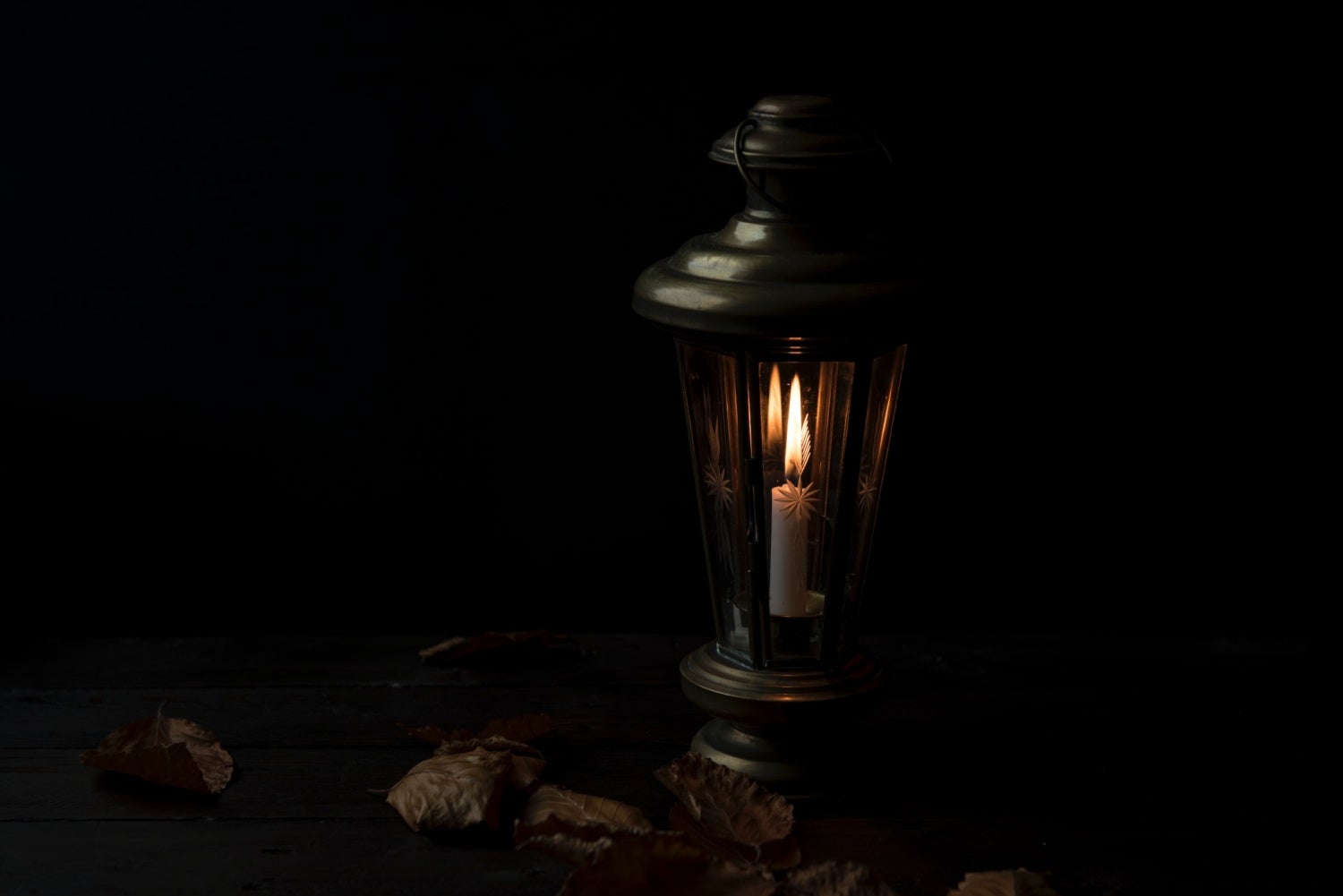
Photo by Joanna Kosinska on Unsplash
While lumens tell you how much light is produced, candella tells you how brightly that light is focused on a particular spot. A high candela rating means a more intense, focused beam—great for long distances or pinpointing specific areas. A lower candela rating results in a wider, less intense beam, ideal for illuminating larger areas at close range. Consider your typical targets and distances to determine the most appropriate candela rating for your needs.
When it comes to understanding the performance of your weapon-mounted light, lumens are just one part of the equation. The other critical factor is candela, a unit of measurement that indicates the intensity of light in a specific direction.
While lumens measure the total output of light, candela measures how that light is distributed or focused. It tells you how brightly a light is concentrated on a particular spot. In essence, if lumens are about quantity, candela is about quality.
High vs. Low Candela Ratings
A high candela rating indicates a more intense, focused beam of light. This type of light is excellent for long distances as it can illuminate specific areas with precision. If you need to pinpoint a target from afar or navigate a path through a dark forest, a high candela count will provide the concentrated light beam necessary for these tasks.
Conversely, a lower candela rating results in a wider, less intense beam of light. This light is perfect for close-range applications where you must illuminate larger areas rather than specific points. For instance, if you’re clearing a room or exploring a dark building, a weapon light with a low candela count will cast a broad beam, allowing you to see more of your surroundings simultaneously.
Choosing the Right Candela Rating
Determining the appropriate candela rating for your needs involves considering your typical targets and distances. If you often engage in activities that require precise, long-distance illumination, a weapon light with a high candela count will serve you best. On the other hand, if your operations are primarily close-range or require broad-area illumination, a lower candela rating would be more suitable.
Remember, the goal is to choose a light that increases your operational effectiveness. Therefore, understanding the concept of candela and how it impacts the performance of your weapon-mounted light is vital. By considering both lumens and candela, you can select a light that provides the right balance of total light output and focused intensity to meet your specific needs.
Size
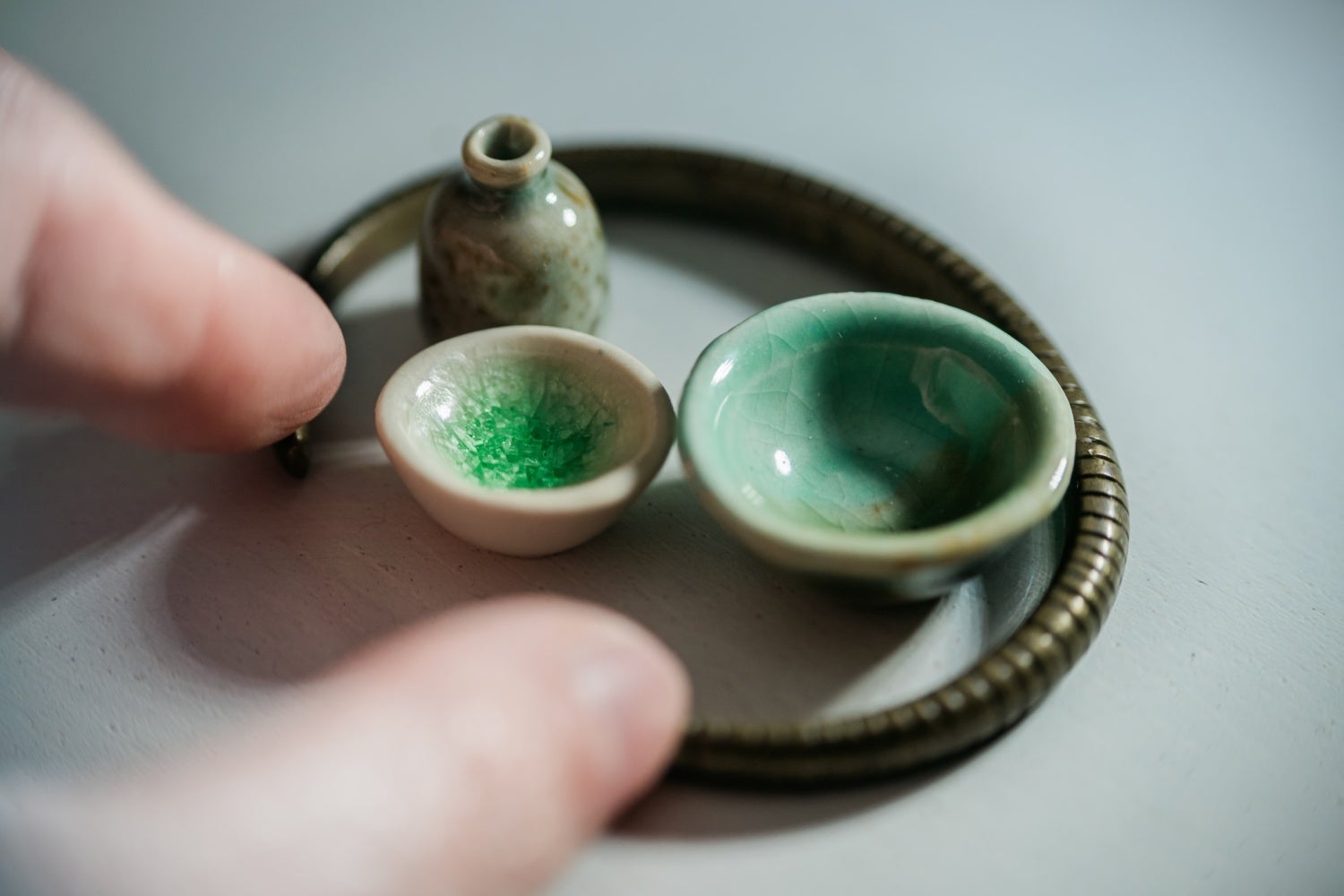
Photo by Gabriella Clare Marino on Unsplash
The size of your weapon-mounted light can affect the balance and handling of your firearm. Larger, full-size lights may offer more features or higher brightness, but they can also make your firearm heavier and potentially harder to handle. Compact lights, on the other hand, are lighter and less likely to change your weapon’s balance, but they might not be as powerful or feature-rich. Consider your firearm type and how much additional weight you’re comfortable with when choosing a light.
When selecting a weapon-mounted light, size is a factor that can significantly influence the performance and handling of your firearm. The dimensions of the light can affect the balance, weight, and overall feel of your weapon, impacting its usability in different tactical situations.
Full-Size Lights
Larger, full-size weapon lights often come with various features and generally provide higher brightness levels due to their bigger size and capacity. They may have more advanced controls, longer battery life, or higher lumen and candela ratings, which can be advantageous in certain scenarios.
However, adding a large light can alter the balance of your firearm, making it heavier and potentially harder to handle. This could affect your shooting accuracy, especially if you’re not accustomed to the extra weight. Moreover, larger lights might protrude beyond the muzzle of compact firearms, which could interfere with holstering and unholstering the weapon.
Compact Lights
Compact weapon lights, on the other hand, are designed to be lightweight and unobtrusive. They are less likely to change your weapon’s balance or impede its handling, making them a popular choice for smaller firearms or users who prioritize maneuverability.
However, their smaller size might limit their power output and feature set. Compact lights may have lower lumen and candela ratings, shorter battery life, or fewer control options than their full-sized counterparts. They might also have a smaller beam spread, limiting the area they can illuminate at once.
Durability
Your weapon-mounted light should be robust enough to withstand the recoil of your firearm and tough environmental conditions. Look for lights made with high-grade materials, such as anodized aluminum, and features like water and impact resistance. A durable light will serve you reliably for years, providing peace of mind that your gear won’t let you down in critical moments.
Durability is a crucial aspect to consider when selecting a weapon-mounted light. The light should be robust enough to endure the recoil of your firearm, withstand harsh environmental conditions, and provide reliable service over an extended period.
Recoil Resistance
One of the primary factors that can affect the durability of your weapon-mounted light is the recoil of your firearm. High-caliber firearms generate significant recoil forces, which can damage lights not designed to absorb such shocks. Therefore, it’s essential to select a light that has been tested and proven to resist the impact of your firearm’s recoil. This ensures the light’s longevity and maintains its functionality even in high-intensity shooting scenarios.
Material Quality
The material from which the light is made significantly contributes to its durability. High-grade materials such as anodized aluminum are commonly used in the construction of weapon lights due to their strength and lightweight properties. Anodized aluminum, for instance, undergoes a process that makes it harder and more corrosion-resistant, enhancing the light’s durability and lifespan.
Environmental Resistance
Your weapon-mounted light should also be able to withstand tough environmental conditions. It must resist water, dust, and impact, ensuring it can function effectively in various tactical scenarios. Water resistance is particularly important if you’re likely to use the light in rainy conditions or near bodies of water. Similarly, impact resistance ensures the light can survive accidental drops or collisions without losing functionality.
Long-Term Reliability
A durable light will provide reliable service for years, giving you confidence in your gear’s performance during critical moments. It means less worry about equipment failure and more focus on the task at hand. This peace of mind is invaluable, especially in high-stakes situations where the reliability of your equipment can mean the difference between success and failure.
In conclusion, when choosing a weapon-mounted light, prioritize durability. Look for lights made with high-grade materials and designed to resist recoil, water, and impact. A durable light might require a higher initial investment, but it pays off in the long run by providing reliable service and reducing the need for replacements.
Design
Design encompasses everything from how the light mounts on your weapon to how you activate it and adjust its settings. Some lights have rear switches, others have side switches; some may offer strobe functions, while others might include a laser sight. There’s no one-size-fits-all answer here – it’s about what feels intuitive and comfortable for you. Consider your personal preferences and operational requirements when evaluating the design of a weapon-mounted light.
Design plays a pivotal role in the functionality and usability of a weapon-mounted light. It covers various aspects, including the mounting mechanism, control interface, and additional features. The design of the light can significantly impact your comfort level, operational efficiency, and overall tactical performance.
Mounting Mechanism
How a light mounts onto your weapon is a key aspect of its design. Some lights may use a rail-mounting system, allowing easy attachment and detachment, while others require more complex installation procedures. The mounting mechanism should provide a secure fit to keep the light in place, even during rapid movement or substantial recoil. Additionally, the position of the light on your firearm can affect your ability to aim accurately and manipulate the weapon effectively.
Control Interface
The positioning and design of the switches that activate the light and adjust its settings are crucial for ease of use. Some lights feature rear switches that can be easily operated with your thumb, while others have side switches that may be more accessible depending on your grip. The control interface should be intuitive and easy to operate, even under stressful conditions. Some designs may also offer ambidextrous controls benefiting right- and left-handed users.
Additional Features
Additional features like strobe functions or laser sights can enhance the versatility of your weapon-mounted light. Strobe functions can disorient targets, providing a tactical advantage in certain situations. Laser sights, however, can improve your aiming precision, especially in low-light conditions. However, these features might add complexity to the light’s operation, so they should align with your operational needs and comfort level.
Personal Preferences and Operational Requirements
Design is highly subjective, and there’s no one-size-fits-all solution. What feels intuitive and comfortable for one person might not work well for another. Therefore, it’s essential to consider your personal preferences and operational requirements when evaluating the design of a weapon-mounted light.
Consider factors like the size of your hand, your preferred shooting grip, your firearm type, and the typical environments in which you operate. Test different lights to find a natural design that enhances your tactical capabilities.
In conclusion, the design of a weapon-mounted light is a multifaceted consideration that can significantly impact its usability and effectiveness. A well-designed light should enhance operational efficiency, feel comfortable and intuitive to use, and align with your personal preferences and tactical requirements.
Weapon Mounted Lights
1. Streamlight TLR-8A
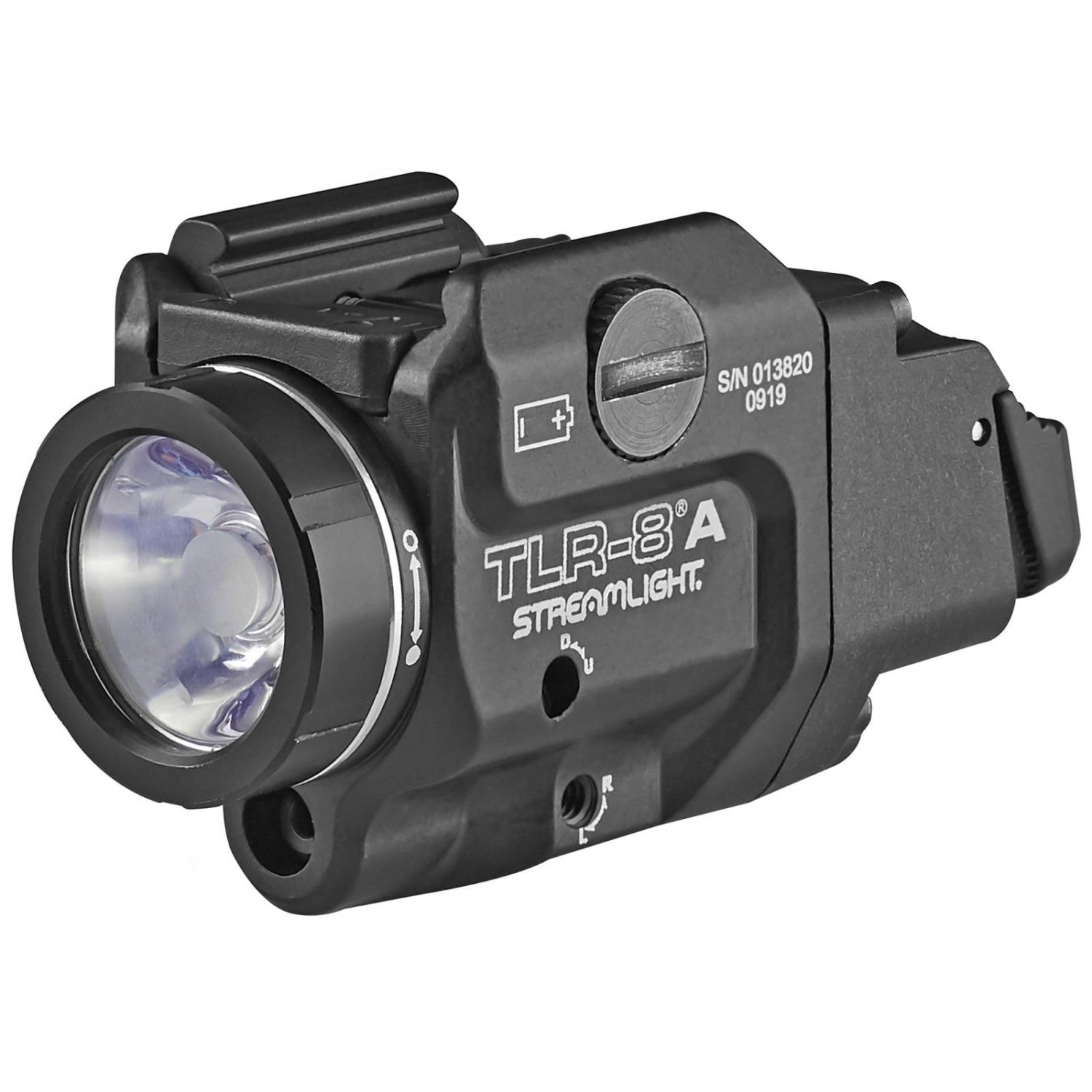
The TLR-8A is a compact weapon light that comes with a red laser. It emits up to 500 lumens of bright light, making it ideal for close to mid-range applications. It has a rear paddle switch design for ease of use and an IPX4 water-resistance rating. However, its compact size might limit its illumination range compared to larger models.
2. Streamlight TLR-7A
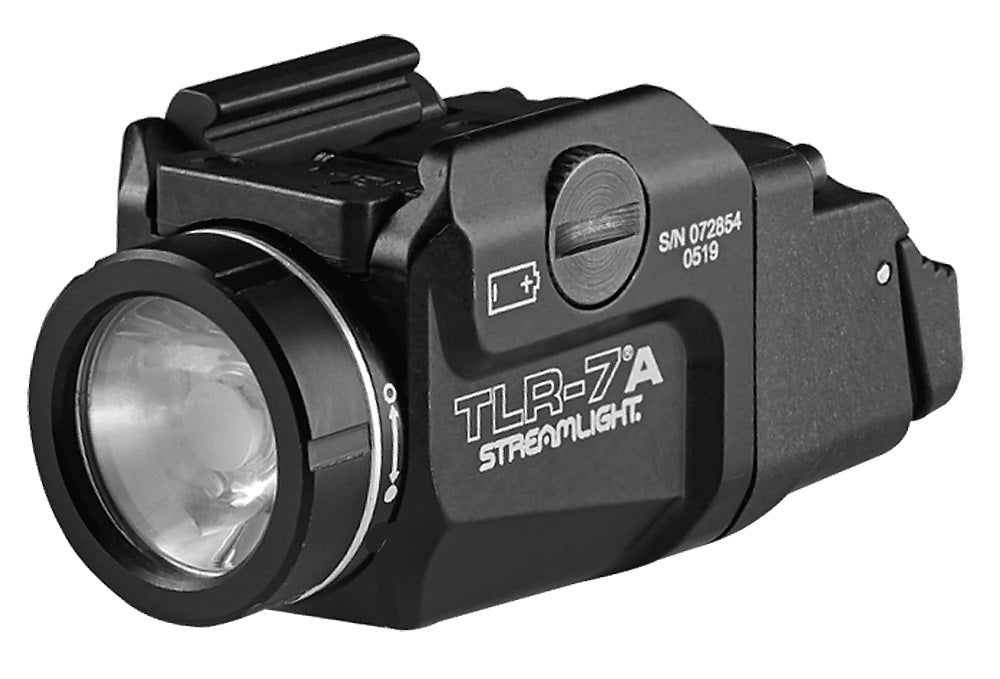
This model is similar to the TLR-8A but without the laser feature. It offers 500 lumens of light and comes with a user-programmable strobe enable/disable function. Its compact design makes it suitable for smaller firearms, but the lack of a laser might be a disadvantage for some users.
3. Surefire X300 Ultra A
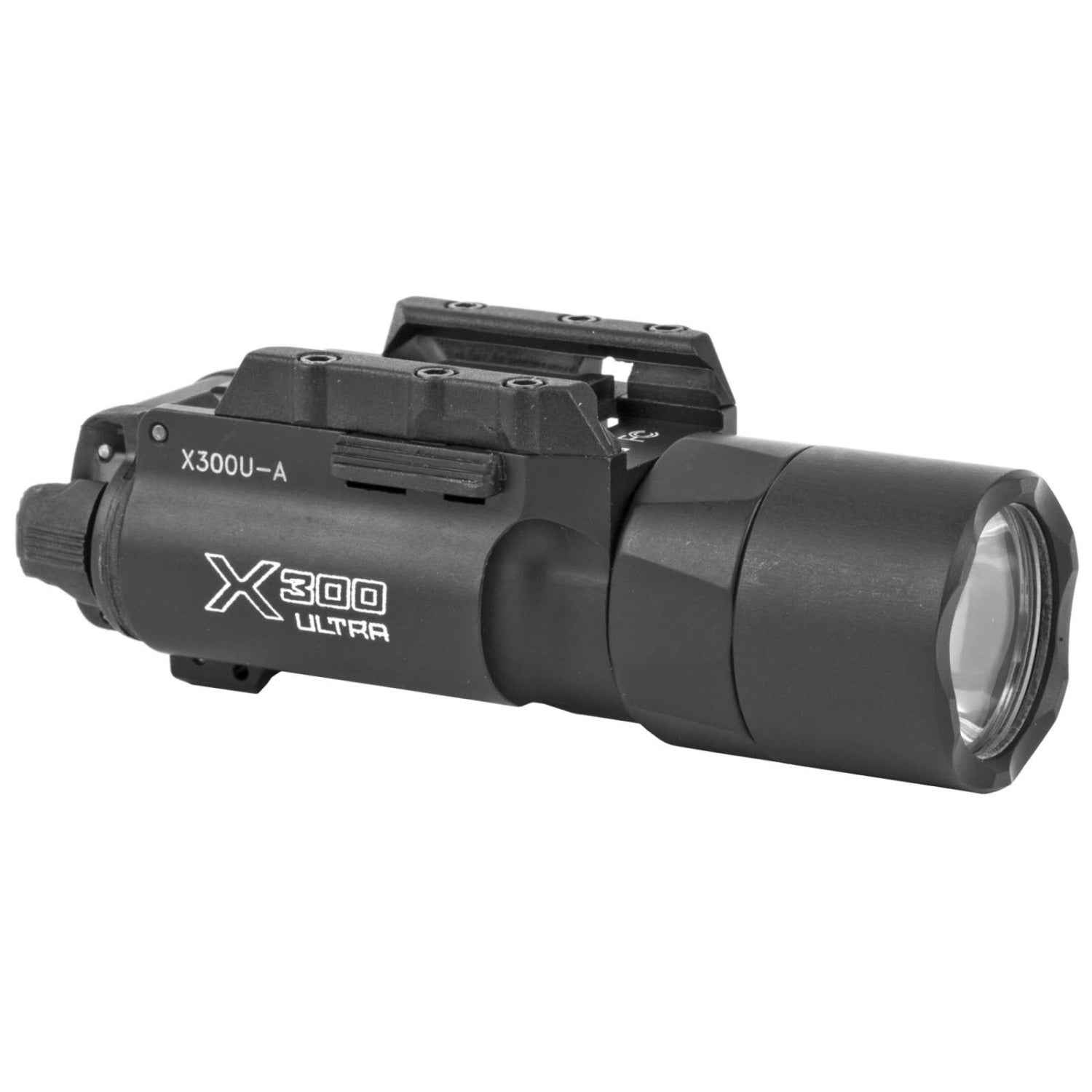
The X300 Ultra A is known for its robust construction and exceptional brightness – up to 1000 lumens. It also features a Rail-Lock® system for rapid attachment/detachment. However, it’s one of the more expensive options on this list, which might not appeal to budget-conscious buyers.
4. Streamlight TLR-1A
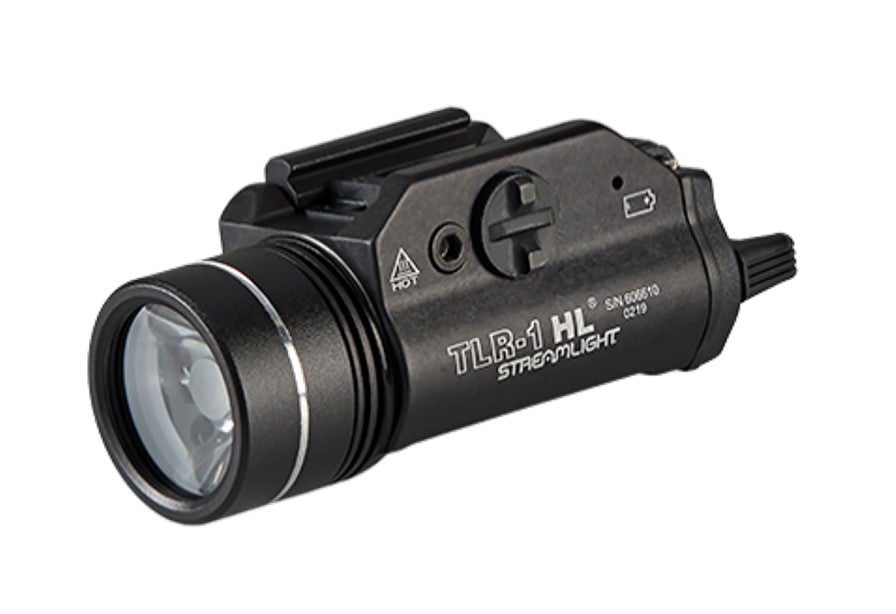
The TLR-1A is a versatile weapon light offering 300 lumens. It’s lightweight, easy to mount, and has a wide beam pattern for optimal peripheral illumination. However, its lower lumen output might not be sufficient for all scenarios.
5. Holosun P.ID Light
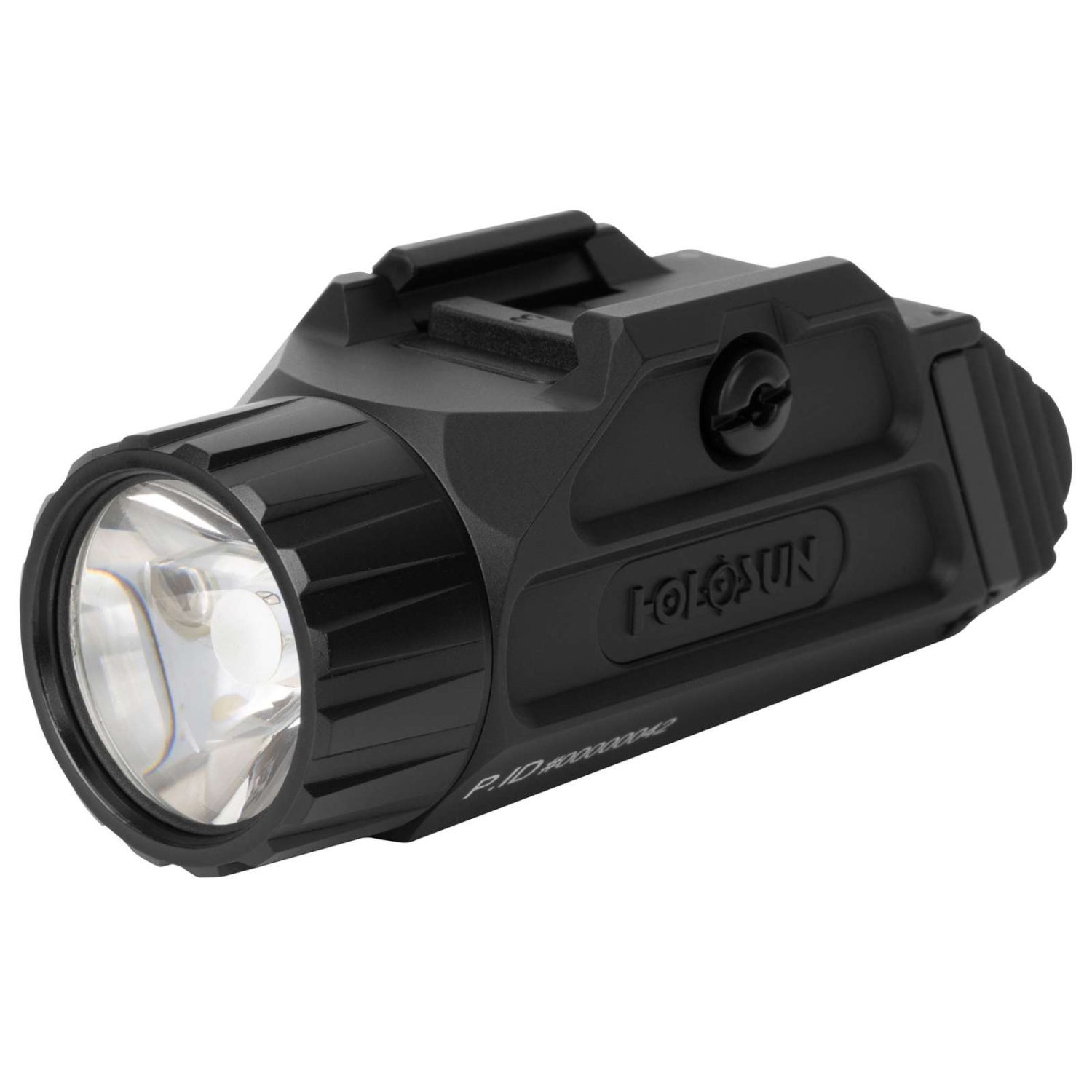
The P.ID light is a newcomer in the market but offers innovative features like motion-sensing activation and adjustable brightness levels. It comes in at 1000 lumens and 23,000 candela and has a rechargeable battery (using an external magnetic charger). However, its a relatively unknown brand for lights (they’ve been doing sights and lasers for a while) might make some users hesitant to purchase.
6. Surefire X300 Ultra Turbo
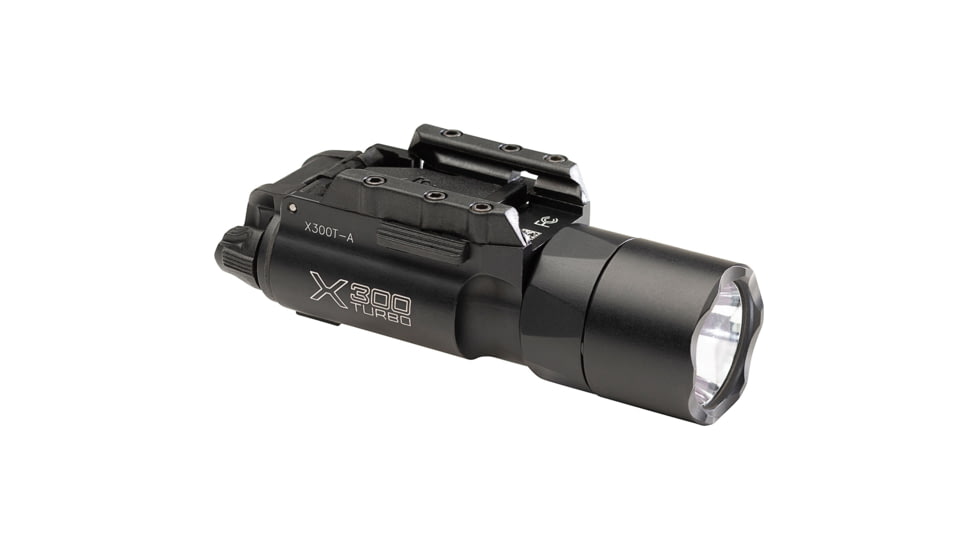
This model boasts an impressive 1000 lumens, similar to the X300 Ultra A, but with a wider beam spread. Its robust construction ensures durability and reliability. However, like the Ultra A, it’s also on the pricier side.
Here’s a quick comparison matrix:
| Product | Lumens | Size | Durability | Design | Price |
| Streamlight TLR-8A | 500 | Compact | High | Rear paddle switch, red laser | $$ |
| Streamlight TLR-7A | 500 | Compact | High | User-programmable switch | $$ |
| Surefire X300 Ultra A | 1000 | Full-size | Very high | Rail-Lock® system | $$$ |
| Streamlight TLR-1A | 1000 | Compact | High | Wide beam pattern | $$ |
| Holosun P.ID Light | 1000 | Compact | Unknown | Motion-sensing activation | $ |
| Surefire X300 Ultra Turbo | 1000 | Full-size | Very high | Wide beam spread | $$$ |
When choosing the best weapon-mounted light, consider your specific needs, firearm compatibility, and budget. Each product performs well in its respective categories, offering unique features that cater to different user preferences.
In conclusion, the right weapon-mounted light can be a game-changer, enhancing your ability to identify targets and respond effectively in low-light situations. By considering these aspects – battery life, lumens, candela, size, durability, and design – you can choose a weapon-mounted light that is reliable, practical, and perfectly suited to your needs. Let this guide illuminate your path to a brighter, safer future.
 Your Privacy Choices
Your Privacy Choices
